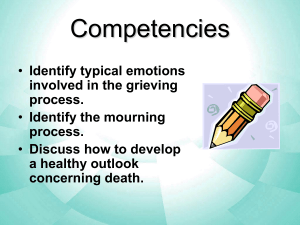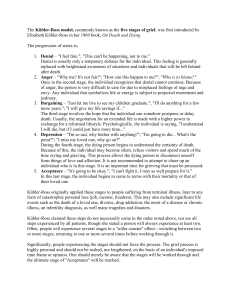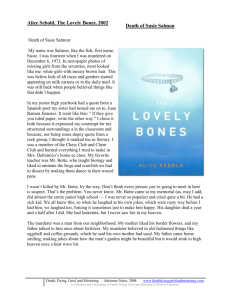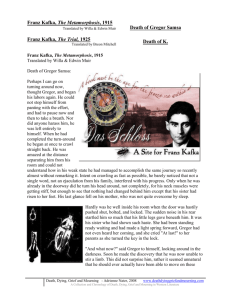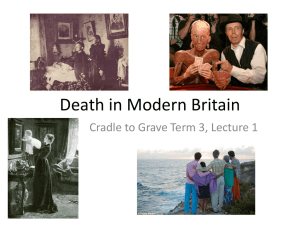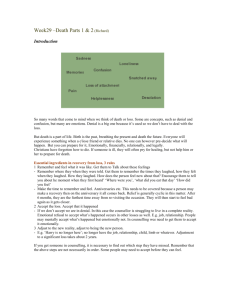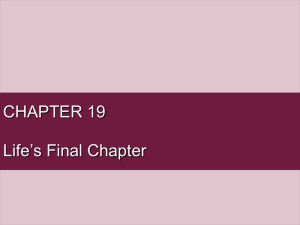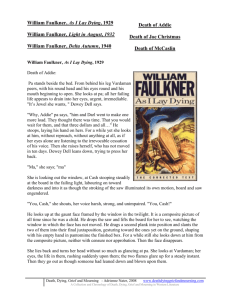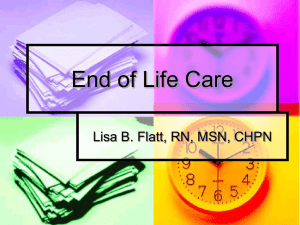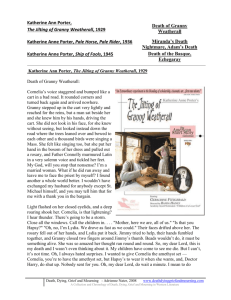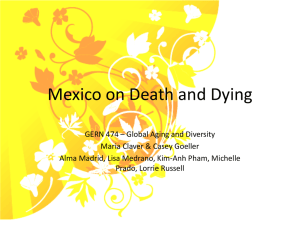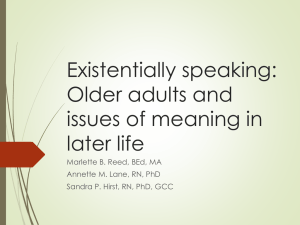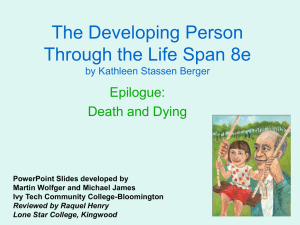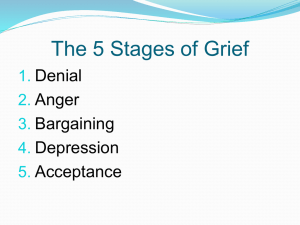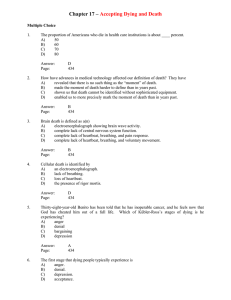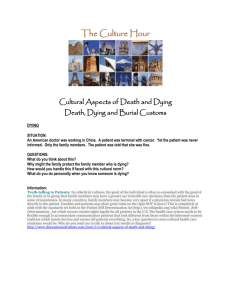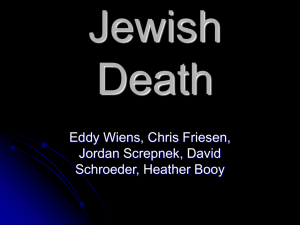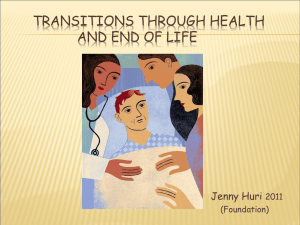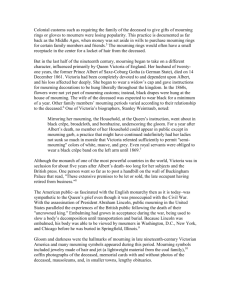Death and Grieving - Gordon State College
advertisement
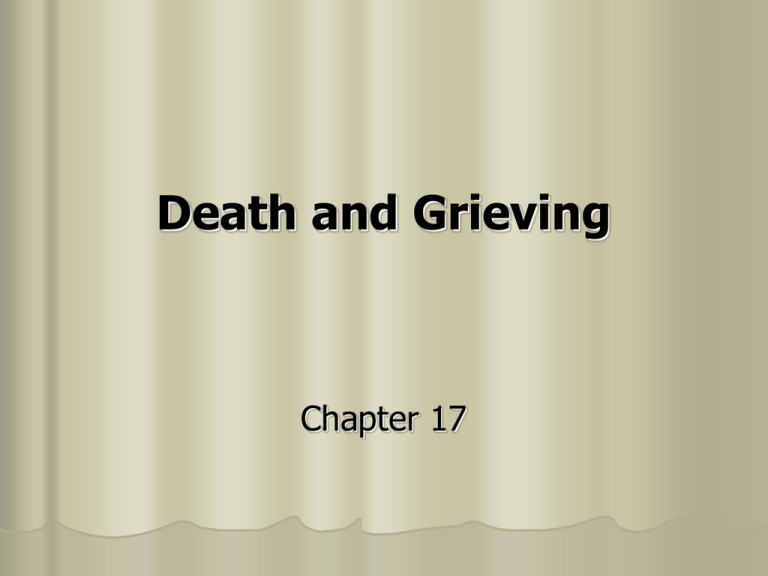
Death and Grieving Chapter 17 Issues in Determining Death Brain death — neurological definition of death All electrical activity of brain has ceased for a specified period of time Flat EEG recording Some medical experts argue criteria for death should include only higher cortical functioning Death becoming increasingly complex 1. When to determine death has occurred? 2. Life expectancy has increased 3. Care for dying shifted away from family 4. Minimized exposure to death and its pain Death in Different Cultures Most societies have Philosophical or religious beliefs about death Rituals that deal with death View that death does not end existence U.S. Denial and Avoidance of Death ? Funeral industry emphasizes lifelike qualities Euphemisms — softening language for death Persistent search for “fountain of youth” Rejection and isolation of aged Hope that everyone goes to heaven Medical emphasis — prolonging life, not easing suffering Attitudes Toward Death at Different Points in the Life Span Childhood Infant has no concept of death; perceptions of death develop in middle/late childhood; even very young children concerned about separation and loss Adolescence Develop more abstract concepts of death; common to think they are immune to death Adulthood Middle-aged adults fear death more than young adults or older adults; older adults think about death more A Developmental Perspective of Death Suicide Risk factors Serious physical illness Feelings of disparity, isolation, failure, loss Serious financial problems Drug use or prior suicide attempts Antidepressant links – Cultural and gender differences exist – Rare in childhood, risk increase in adolescence – Most adolescent attempts fail – Linked to genetic and situational factors – Gay or lesbian links not clear Facing One’s Own Death Most dying individuals want to make decisions regarding their life and death Complete unfinished business Resolve problems and conflicts Put their affairs in order Kubler-Ross’ Stages of Dying Denial and isolation Denies s/he is going to die Anger Denial gives way to anger, resentment, rage, and envy Bargaining Develops hope that death can somehow be postponed Depression Comes to accept the certainty of her or his death Acceptance Develops sense of peace and may desire to be left alone Perceived Control and Denial When individuals believe they can influence and control events, they may become more alert and cheerful Denial can be adaptive or maladaptive Care for Dying Individuals ? Death in U.S.: often lonely, prolonged, painful Plan for your death Make a living will Give someone power of attorney Give your doctor specific instructions Discuss desires with family and doctor Check insurance plan coverage The Contexts in Which People Die Most would rather die at home but worry over Burden at home Limited space May alter relationships Competency and availability of emergency medical treatment Communicating with the Dying Person Establish your presence Eliminate distraction Ask if there is anyone s/he would like to see Encourage the dying individual to reminisce Limit visit time Don’t insist on acceptance Talk with the individual when s/he wishes to talk Allow expressions of guilt or anger Express your regard Discuss alternatives, unfinished business Decisions Regarding Life, Death, and Health Care Natural Death Act and Advance Directive Expresses person’s desires regarding extraordinary medical procedures that might be used to sustain life when medical situation becomes hopeless Euthanasia Painlessly ending lives of persons suffering from incurable diseases or severe disabilities Passive euthanasia — withholding of available treatments, allowing the person to die Active euthanasia — death induced deliberately, as by injecting a lethal dose of drug Publicized controversy: assisted suicide Care for Dying Individuals Hospice — humanized program committed to making the end of life as free from pain, anxiety, and depression as possible Palliative care — reducing pain and suffering and helping individuals die with dignity When Others Decide Remember Terry Schaivo What is a persistent vegetative state? Who decides? What are their motives? Should the government decide? Social security bankruptcy – workerpensioner imbalance Medicare/Medicaid bankruptcy Generational inequity – rationing of care Grieving Grief: emotional numbness; a complex emotional state of… Disbelief Separation anxiety Despair Sadness Loneliness …that accompanies loss of someone we love Cultural Diversity in Healthy Grieving Contemporary western orientation Breaking bonds with the dead Returning survivors to autonomous lifestyle Non-Western cultures Maintaining ties with deceased Influenced by religious beliefs and lifestyle Making Sense of Grief Grieving stimulates many to try to make sense of their world — positive themes linked to hopeful future and better adjustment Effort to make sense of it pursued more vigorously when caused by an accident or disaster Losing a Life Partner Those left behind after the death of an intimate partner suffer profound grief and often endure Financial loss Loneliness linked to poverty and education Increased physical illness Psychological disorders, including depression Marital Quality and Adjustment to Widowhood Widowhood associated with increased anxiety among those highly dependent on their spouses Lower anxiety for those who did not depend on their spouse very much Forms of Mourning Approximately 80 percent of corpses are disposed of by burial, the remaining 20 percent by cremation Funeral industry is source of controversy Funeral is important aspect of mourning in many cultures Cultures vary in how they practice mourning Amish Mourning Conservative group; family-oriented society Live same unhurried pace as ancestors Time of death met with calm acceptance Neighbors notify community; funeral at home High level of support to family for one year Traditional Judaism and Mourning Mourning in graduated time periods; each with appropriate practices 1st period: Aninut — between death and burial 2nd period: Avelut period — mourning proper Shivah period — 7-day begins at burial Sheloshim period — 30-day period after burial Mourning over for all but parents who mourn another 11 months
